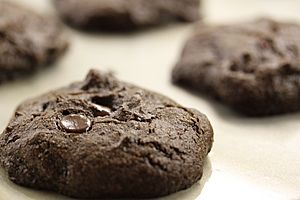Carob tree facts for kids
Quick facts for kids Carob tree |
|
|---|---|
 |
|
| Illustration of Ceratonia siliqua | |
| Scientific classification | |
| Kingdom: | |
| (unranked): | |
| (unranked): | |
| (unranked): | |
| Order: | |
| Family: | |
| Genus: | |
| Species: |
C. siliqua
|
| Binomial name | |
| Ceratonia siliqua |
|
The carob tree is a type of flowering evergreen tree. It belongs to the pea family, called Fabaceae. Its scientific name is Ceratonia siliqua.
People grow carob trees for their tasty edible pods. They also plant them as ornamental trees in gardens. The ripe, dried carob pods are often ground into carob powder. This powder can be used instead of cocoa powder. You can find carob bars, which are like chocolate bars, in many health food stores.
Contents
What is the Carob Tree Called?
The carob tree has a few different names in English. It's known as the carob tree, St John's-bread, or locust bean. Just be careful not to confuse it with the African locust bean.
The word carob comes from an old French word, carobe. This word was borrowed from the Arabic word kharrūb, which means "locust bean pod".
Here are some common names in other languages:
- French: caroube, caroubier
- German: Johannisbrotbraum
- Portuguese: alfarrobeira
- Spanish: algarrobo, caroba
The scientific name, Ceratonia siliqua, was given by Carl Linnaeus. It comes from Greek and Latin words. Kerátiοn means 'fruit of the carob', and siliqua means 'pod'.
Did you know the word carat comes from the Greek word for a carob seed? A carat is a unit of mass for gemstones and a unit of purity for gold.
What Does the Carob Tree Look Like?
The carob tree can grow up to 15 meters (about 49 feet) tall. It has a wide, rounded top, called a crown. This crown is held up by a thick trunk with rough brown bark. Its branches are strong and firm.
The leaves are 10 to 20 centimeters (about 4 to 8 inches) long. They grow in an alternating pattern and are made up of several smaller leaflets.
Most carob trees are dioecious. This means they have separate male and female plants. Only the female plants produce fruit. Some carob trees are hermaphrodite, meaning they have both male and female parts on the same plant.
The trees bloom in autumn. Their flowers are small and grow in clusters. Both wind and insects help to pollinate the flowers.
The fruit of the carob tree is a legume, also known as a pod. These pods take a whole year to grow and ripen. Once they are sweet and ripe, they fall to the ground. Animals like goats, sheep and cows eat them. This helps to spread the hard seeds.
Where Do Carob Trees Grow?
The carob tree is originally from places like Cyprus, Egypt, Israel, Palestine, Jordan, Lebanon, Libya, Saudi Arabia, Syria, Tunisia, and Turkey.
It usually grows in areas between 30-45°N and 30-40°S. It can be found from sea level up to about 500 to 1000 meters (1,600 to 3,300 feet) high. People have also planted carob trees in other regions with a similar Mediterranean climate.
How Do People Use Carob?
Carob as Food
Humans eat the dried carob pods. Sometimes, the pods are also roasted. Inside the pod, there are 5 to 18 hard brown seeds. These seeds make up about 10% of the pod's weight. The rest is a sweet, thick pulp.
Carob has a mild, sweet taste. It is used in powder, chip, or syrup form. You can find it as an ingredient in cakes and cookies. It is also a popular substitute for chocolate. Carob bars are easy to find in health food stores. In Malta, a traditional sweet treat is made from carob pods, especially eaten during Lent and Good Friday.
Carob pod meal is also used to feed farm animals. It gives them a lot of energy.
Carob Syrup and Drinks
In Cyprus, carob syrup is called "Cyprus's black gold." It is sold to many other countries. In Malta, a syrup called ġulepp tal-ħarrub is made from carob pods.
Carob syrup is also used in Crete as a natural sweetener. It is known for being a natural source of calcium. It has three times more calcium than milk! It also has lots of iron, phosphorus, and natural fibers. Because of its strong taste, it is sometimes mixed with orange or chocolate flavors.
Carob juice drinks are often enjoyed during the Islamic month of Ramadan. Crushed carob pods can be used to make a beverage. People in Turkey, Malta, Portugal, Spain, and Sicily also make compote, liqueur, and syrup from carob. Some studies suggest that carob might help with treating diarrhea in babies.
Carob as an Ornamental Plant
The carob tree is widely planted as an ornamental plant in gardens. It grows well in Mediterranean climates and other temperate regions around the world. For example, you can find it planted in California and Hawaii. The plant can also be used to create a thick and large hedge.
Where is Carob Produced?
Here are the top countries that produce carob, based on information from the UN Food & Agriculture Organisation (FAO) in 2012:
 Spain 40,000 metric tonnes (estimated)
Spain 40,000 metric tonnes (estimated) Italy 30,841 metric tonnes
Italy 30,841 metric tonnes Portugal 23,000 metric tonnes (estimated)
Portugal 23,000 metric tonnes (estimated) Greece 22,000 metric tonnes (estimated)
Greece 22,000 metric tonnes (estimated) Morocco 20,500 metric tonnes (estimated)
Morocco 20,500 metric tonnes (estimated) Turkey 14,218 metric tonnes
Turkey 14,218 metric tonnes Cyprus 5,186 metric tonnes
Cyprus 5,186 metric tonnes Algeria 3,136 metric tonnes
Algeria 3,136 metric tonnes Lebanon 2,300 metric tonnes (estimated)
Lebanon 2,300 metric tonnes (estimated)
Images for kids
-
Carob tree in Jerusalem
See also
 In Spanish: Algarrobo para niños
In Spanish: Algarrobo para niños
















